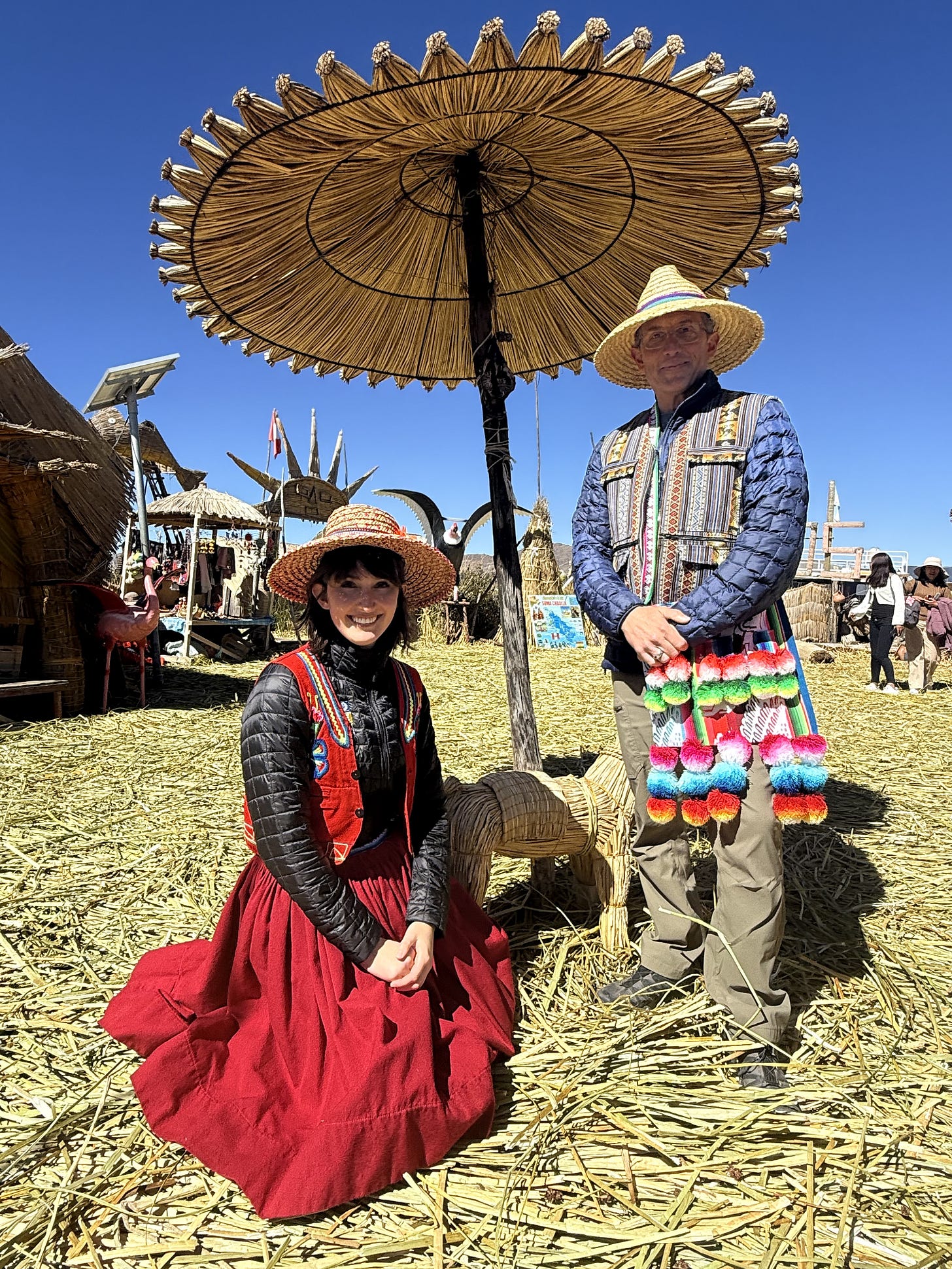Lessons on Conflict Resolution from Lake Titicaca
What the Uros can teach us about conflict and knowing when to cut loose
I’ve written here about a recent trip to Peru that my daughter and I took. One of the many highlights was visiting Lake Titicaca, billed as the highest navigable lake in the world. It sits at over 12,500 feet (3,812 meters) above sea level and straddles the border between Peru and Bolivia.
As a kid, my grandfather gifted me a subscription to National Geographic one Christmas, and I can still recall the excitement with which I unwrapped the brown paper covering each new issue as it arrived. One of those issues featured a profile on Lake Titicaca, and ever since, the idea of floating communities has lingered somewhere in the back of my mind anytime anyone mentions the lake with the comical name. (Our Peruvian guide, with a nod to the recurring border tensions between his country and Bolivia, was quick to point out, “Our side of the lake is the Titi side and the Bolivian side is the Caca.”) We also learned that the local pronunciation is much more guttural, and therefore not as scatological-sounding as it may seem in English.
Our itinerary simply mentioned “lake tour by boat,” and I was imagining some sort of leisurely drift as we sipped drinks on board. I was surprised, then, when our guide mentioned we would be visiting the Uros, a community that has lived on floating islands for centuries.
We took a motorboat out to the entrance of the nearest Uros community. There was a floating toll station where our captain deftly dropped a five Sol coin as we drifted past—the Uros now primarily survive from tourism revenue, and these tolls, along with the merchandise sold on each island, are a vital source of income.
The boat slid up alongside one of the islands, and two women greeted us in their native Aymara as well as Spanish, waving warmly. I stepped onto the island and immediately felt the surface ripple with each step. We were literally walking on water. The islands are constructed from local totora reeds harvested from the shallows of the lake and then tightly layered in alternating crisscross patterns. As the reeds on the bottom begin to rot, new layers are added to the top; the islands require constant maintenance.
The reeds serve multiple functions: not only as flooring for the islands but also as building material for homes, traditional boats (though many families now also own small motorboats), and even as food. The white inner root of the reed is edible and contains iodine and other nutrients believed to help prevent goiter, a condition once common in the region due to iodine deficiency.
We were treated to a brief demonstration of how the islands were built, along with a history lesson. The Uros people, originally a distinct ethnic group, are believed to have fled the mainland more than 500 years ago—some sources trace their migration back over a millennium—after conflicts with the Incas and other Andean groups. Taking to the lake in reed boats, they eventually began binding these boats together to form floating platforms, which evolved into permanent islands. Today, the islands are anchored to the lakebed with ropes tied to eucalyptus posts, but they can still be moved when necessary.
My daughter and I browsed for souvenirs, and one of the women offered to dress us in traditional Uros attire for a photo. The dwellings on the first island we visited were very close together (we stopped at a second on our way back to the mainland where there was a small café and a floating outhouse). I had to wonder about friction within and between families living in such proximity, so I asked our guide about conflict resolution.
He smiled and picked up a large metal handsaw about three feet long with sharp-looking teeth. I thought he was going to make a joke about execution (we had, by this point, had several guides who, when leading us through sites where ceremonial sacrifice had reportedly occurred, would ask the tour group for volunteers to be sacrificed).
“Each island tries to resolve its own conflicts communally,” he said with a grin. “Most of the time this works. But when it doesn’t, they use the saw to literally cut the island in half, and one or more families can float away and anchor elsewhere. It is very practical.”
Following this visit, I reflected on this approach to conflict—how practical it sounds, but also how perilous. From a survival standpoint, especially in a communal culture, cutting loose and floating away could well foreshadow a future of isolation and privation.
I thought about the current state of affairs in our own communities, cities, and nation—not to mention the world. How many of us would be pulling out the metaphorical saw to divide up our “islands”? How many of us would want others to float away to make our lives easier, less conflictive, more peaceful?
By modern standards, the Uros have very little in a material sense, and what they do have seems precariously temporary. The very islands they inhabit require ongoing care and constant layering, or they risk sinking. The dried reeds pose fire hazards that can wipe out an entire island in minutes. All children must learn to swim at an early age for survival, and beginning in early elementary school, they paddle their own boats to the floating schoolhouse.
And yet, at risk of romanticizing an indigenous lifestyle that surely includes hardship, risk, and sacrifice, there’s something undeniably compelling about the Uros’ way of life. They don’t live behind the façade of security that so many of us cling to. When conflicts threaten the cohesion of the community, they make a collective decision to separate and start anew.
That sounds pretty liberating.






